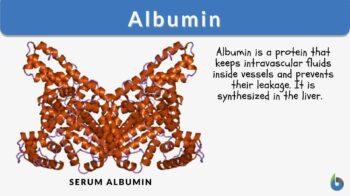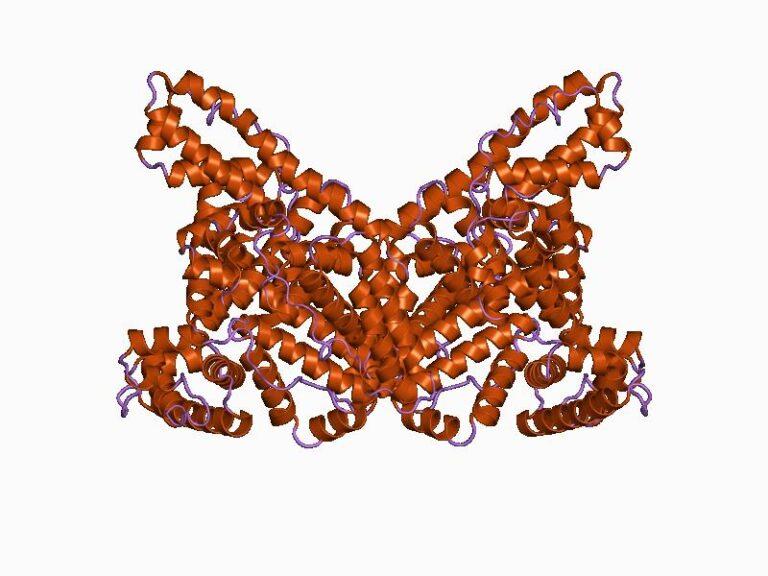
Albumin
n., plural: albumins
[æl.ˈbjuː.mən]
Definition: a colloid molecule that plays an important role in generating oncotic pressure
Table of Contents
Albumin Definition
What is albumin? Is albumin a protein? In biology, albumin is a protein that is responsible for the hemostasis of fluids in the body. Albumin is one of the most important proteins circulating in the bloodstream. Where is albumin found? Albumin is produced by the liver “the main factory for albumin”, it is released by the liver into the bloodstream at the rate of 10 to 15 gm per day. In some cases of kidney damage, albumin in the urine may be detected where excess albumin is excreted by the kidney.
The albumin normal range in the bloodstream is 3.5 to 5 grams per dl, it forms about half of the total protein content in the bloodstream. Albumin is soluble in the water, its half-life is about 27 days. Albumin has various binding sites that enable it to attract and interact with a wide range of organic and inorganic components such as ascorbic acid, which is a general antioxidant.
Human albumin is the main plasma protein that forms about 50 to 60% of total plasma proteins. Albumin is a colloid molecule that plays an important role in generating the oncotic pressure that is generated to overcome and prevent the movement of solvents from high concentration regions to low concentration regions. The oncotic pressure is the form of osmotic pressure induced by albumin in the plasma. The pressure is the tendency of the plasma to be pulled back into the capillary.
The controlling of oncotic pressure is not the only function of albumin, in the medical field, albumin is also defined or regarded as a carrier for drugs. Albumin is produced by the liver and released into the bloodstream.
There are many types of albumin. Six types are considered animal albumin. Two types are found in the human bloodstream such as bovine and human serum albumin. Two types are found in food, such as ovalbumin found in eggs and lactalbumin found in mammary glands.
Biology definition:
Albumin is a water-soluble protein with a molecular weight of 66/5 kDa. It is found in egg white, blood, lymph, tissues, and other fluids. It is the major plasma protein responsible for plasma colloidal osmotic pressure. Its role is to transport protein carrying large organic anions (e.g. fatty acids, bilirubin, and many drugs), and certain hormones (e.g. cortisol and thyroxine), when the specific binding globulins are saturated. The serum albumin is synthesized in the liver. Low serum levels occur in protein malnutrition, active inflammation, and serious hepatic and renal disease.
Etymology: Latin albūmen, from albus, “white”
Variant: albumen
Albumin Function
Albumin has various functions in the bloodstream as it is the main protein and the most abundant in the bloodstream. What is the osmotic and oncotic pressure? Albumin plays an important role in generating oncotic pressure. Osmotic pressure is the pressure that is generated by the solute molecules to prevent solvents such as water from leaking out from regions of low concentration of solute to regions of has a high concentration of solute through semi-permeable membranes like blood vessels.
Why does the solvent or liquid leak out from the vessels? The hydrostatic pressure that is generated by the pumping force of the heart is the main force that causes the fluids to leak out of the organs and vessels. So, the osmotic pressure is the opposite force of the hydrostatic pressure.
The oncotic pressure is a part of osmotic pressure. However, oncotic pressure is mainly used for explaining the osmotic pressure in biological fluids such as plasma. Besides that, unlike osmotic pressure, which is mainly produced by small molecules, oncotic pressure is produced by colloids or large molecules of proteins such as albumin and globulin. So, oncotic pressure is also called colloid osmotic pressure.
Because of the large molecular weight and the negative charge on it, albumin is responsible for producing an oncotic pressure to prevent the solvent from moving from the low solute concentration region to the high solute concentration region. Consequently, albumin reserves dynamic equilibrium in and around blood vessels and organs.
What are the functions of albumin? Here are the various functions of albumin:
1. The main purpose of albumin is to produce and control oncotic pressure.
2. It is the main transporter plasma protein; since it interacts with the ligands to transport them, either endogenous ligands (such as bilirubin and fatty acids) or exogenous ligands. In medical definition, albumin may serve as a carrier for exogenous ligands, such as drugs. For example:
- Propranolol is a non-selective beta-blocker used in controlling blood pressure.
- Warfarin is an anticoagulant drug. Not mainly used nowadays as it has various side effects and interacts with a wide range of drugs such as NSAIDS as diclofenac.
- Furosemide is a diuretic drug used commonly to control high blood pressure.
3. It acts as the main antioxidant in the bloodstream that can interact with metals and free radicals to prevent damage to organs.
4. Albumin can be used as a colloid fluid instead of normal saline and lactated ringer solution in treating hypovolemic shock mainly due to bleeding.
Albumin can perform its normal functions when the normal range is between 3.5 to 5 gram per dl. However, clinical symptoms may develop if the range is higher or lower. If the range is below 3.5 hypoalbuminemia occurs in the following cases:
1. Low production of albumin by the liver. This deficiency is observed in patients suffering from chronic cirrhosis.
2. Nutritional deficiency; this case can be observed especially in children and is called kwashiorkor where albumin malnutrition is caused by decreased intake of amino acids.
3. Loss of albumin By:
- the kidney: normal range of loss by the kidney is less than 30 mg per day. Conditions such as nephrotic syndrome or glomerulonephritis may increase the amount of albumin loss per day.
- the gut; and this case is called protein-losing enteropathy.
- Extravascular loss: such as in burns where albumin is lost from the intravascular system to the extravascular area.
- Sepsis is one of the causes of loss of albumin.
The treatment of hypoalbuminemia is by resolving the cause and then resolving the consequences. For example, hypoalbuminemia is observed in cirrhosis. therefore, when cirrhosis is treated, hypoalbuminemia is resolved. Similarly, in burns, an IV infusion of albumin is given to compensate for the loss of albumin.
In contrast, albumin high levels can be detected if the range of albumin is higher than 5, this case is called hyperalbuminemia.
Either hyperalbuminemia or hypoalbuminemia can be detected by an albumin blood test, which is an albumin test that determines the ratio of albumin in the bloodstream either elevated albumin level if the ratio is higher than 5 or low serum albumin level if the ratio is lower than 3.5
Classification
Albumin of animals can be subdivided into 6 categories as follows:
- category 1 to 3 are vitamin D binding proteins
- category 4 to 6 belong to mix albumin category
In humans, there are two types only of liver albumin proteins found in plasma which are:
- Human serum albumin is the most common type. It is a low albumin molecular weight (molecular weight is 66348 Da). It compensates for low blood albumin volume, carries drugs for delivery, and stabilization of drugs and biological samples. Human serum albumin is commonly used as it is available, has no toxic effect, and is biodegradable.
- Bovine serum albumin has a molecular weight higher than human serum albumin. Its molecular weight is 69323 Da. It is commonly used in drug delivery as it has a low cost and can be purified easily. Bovine is denatured at temperatures between 2 to 64℃. What is the denaturation? Denaturation is the process in which protein is folded at a specific temperature.
Other albumin types
There are other types of albumins apart from the ones described above. They are as follows:
- Ovalbumin is an egg white albumin. It forms about 55 % of egg proteins. It is referred to as white protein in eggs. Ovalbumin’s molecular weight is 44.5 Da. The sequence of amino acids in ovalbumin consists of 385 residues. Ovalbumin has no sulfhydryl group. When ovalbumin is purified, there are three different subgroups that can be detected; A1 which has 2 phosphates groups, A2 which has 1 phosphate group, and A3 which has no phosphate group. When ovalbumin is stored, it is converted to S-ovalbumin which is more heat stable than ovalbumin. The temperature of denaturation of ovalbumin is 84.5℃ and the S-ovalbumin is 92.5℃. It is commonly used as a carrier in controlling drug release because of its low cost and availability
- Alpha Lactalbumin is the protein of the milk. It has four types: bovine, equine, asinine, and human type. This albumin is a metalloprotein. Alpha-lactalbumin has a significant role in regulating the production of lactose in the mammary glands. Alpha-lactalbumin contains 123 amino acids. The most common type of alpha-lactalbumin is equine found in three different genetic forms; A, B, and C. The main difference between A and B forms is that the positions number 7, 33, 54, 78, and 95 contain Glu, Ser, Gln, Asp, and Ile residues of amino acids in type A. On other hand, the same positions in type B contain Gln, Asp, Glu, Asn, and Asp residues of amino acids. In contrast, type c is similar to type B but differs only in position number 95 as type B contains Asp residue of amino acid but type c contains Ile residue. All alpha-lactalbumin have no sulfhydryl group.
Albumin Structure
Albumin is a single protein chain. Generally, its molecular weight is 66/5 Kda. Albumin has 585 amino acids, it also has 17 pairs of disulfide bridges. It is a non-glycosylated polypeptide. Albumin’s cavities are hydrophobic. It has no prosthetic groups. The location of human albumin in the genes of the chromosome are found in number 11 to 22. The number of nucleotides is 1691 — with 14 introns and 15 exons.
Albumin has three domains that are homologous:
- Domain I is in residues from number 1 to 195.
- Domain II is in residues from number 196 to 383.
- Domain III is in residues from 384 to 585.
The individual domain consists of two identical subunits which are A and B. By using x-ray crystallography, the heart shape of albumin is detected.

Try to answer the quiz below to check what you have learned so far about albumin.
References
- Albumin: Actions and alterations. Benefits of supplementation with buffered albumin: Pralbumin. Melcalin. (2022, March 22). Retrieved April 6, 2022, from https://melcalin.com/en/albumin-actions-and-alterations-benefits-of-supplementation-with-buffered-albumin-pralbumin/
- Albumins. Albumin – An Overview | ScienceDirect Topics. (n.d.). Retrieved April 6, 2022, from https://www.sciencedirect.com/topics/physics-and-astronomy/albumins
- Cassaza, A. the A. L., Cassaza, L., & *, N. (2021, January 20). Albumin: Function & Associated Diseases. SelfDecode Labs. Retrieved April 7, 2022, from https://labs.selfdecode.com/blog/albumin/
- Dr. Samanthi. (2018, April 21). Difference between osmotic pressure and oncotic pressure. Contrast the Difference Between Similar Terms. Retrieved April 7, 2022, from https://www.differencebetween.com/difference-between-osmotic-pressure-and-vs-oncotic-pressure/
- Encyclopædia Britannica, inc. (n.d.). Albumin. Encyclopædia Britannica. Retrieved April 6, 2022, from https://www.britannica.com/science/albumin
- Hypoalbuminemia – StatPearls – NCBI Bookshelf. (n.d.). Retrieved April 7, 2022, from https://www.ncbi.nlm.nih.gov/books/NBK526080/
- Lactalbumin. Lactalbumin – an overview | ScienceDirect Topics. (n.d.). Retrieved April 7, 2022, from https://www.sciencedirect.com/topics/food-science/lactalbumin
- Ovalbumin. Ovalbumin – an overview | ScienceDirect Topics. (n.d.). Retrieved April 7, 2022, from https://www.sciencedirect.com/topics/agricultural-and-biological-sciences/ovalbumin
- Physiology, albumin – statpearls – NCBI bookshelf. (n.d.). Retrieved April 7, 2022, from https://www.ncbi.nlm.nih.gov/books/NBK459198/
- Raoufinia, R., Mota, A., Keyhanvar, N., Safari, F., Shamekhi, S., & Abdolalizadeh, J. (2016, December). Overview of albumin and its purification methods . Advanced pharmaceutical bulletin. Retrieved April 7, 2022, from https://www.ncbi.nlm.nih.gov/pmc/articles/PMC5241407/#!po=4.21687
©BiologyOnline.com. Content provided and moderated by Biology Online Editors.


